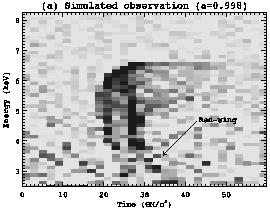


The rapid X-ray variability of many Seyfert galaxies leads us to believe that the primary X-rays are emitted during dramatic flare-like events in the accretion disk corona. When a new flare becomes active, the hard X-rays from the flare will propagate down to the cold disk and excite iron fluorescence. Due to the finite speed of light, the illumination from the flare sweeps across the disk, and the reflected X-rays act as an `echo' of this flare. Such flaring will cause temporal changes in the iron line profile and strength due to the changing illumination pattern of the disk and, more interestingly, time delays between the observed flare and the its fluorescent echo. This latter effect is known as reverberation.
In principal, reverberation provides powerful diagnostics of the space-time geometry and the geometry of the X-ray source. When attempting to understand reverberation, the basic unit to consider is the point-source transfer function, which gives the response of the observed iron line to an X-ray flash at a given location. As a starting point, one could imagine studying the brightest flares in real AGN and comparing the line variability to these point-source transfer functions in an attempt to measure the black hole mass, spin and the location of the X-ray flare. By studying such transfer functions, it is found that rapidly rotating black holes possess a characteristic reverberation signature. In the case where the fluorescing part of the accretion disk extends down to the radius of marginal stability of a near-extremal kerr black hole, the instantaneous iron line profile displays a low-energy bump which moves to lower-energies on a timescale of GM / c3. This feature corresponds to highly redshifted and delayed line emission that originates from an inwardly moving ring of illumination/fluorescence that asymptotically freezes at the horizon (see Reynolds et al. 1999 and Young & Reynolds 2000 for a detailed discussion of this feature).
The primary observational difficulty in characterizing iron line
reverberation will be to obtain the required signal-to-noise. One must
be able to measure an iron line profile on a timescale of
treverb ~ GM / c3
 500 M8 s,
where we have normalized to a central black hole mass of 108
M
500 M8 s,
where we have normalized to a central black hole mass of 108
M . This requires an
instrument with at least the collecting area of XMM-Newton, and probably
Constellation-X. Figure 11 shows that
Constellation-X can
indeed detect reverberation from a bright AGN with a mass of
108
M
. This requires an
instrument with at least the collecting area of XMM-Newton, and probably
Constellation-X. Figure 11 shows that
Constellation-X can
indeed detect reverberation from a bright AGN with a mass of
108
M . Furthermore,
the signatures of black hole spin may well be
within reach of Constellation-X
(Young & Reynolds 2000).
Although these simulations make the somewhat artificial assumption that
the X-ray flare is instantaneous and located on the axis of the system,
it provides encouragement that reverberation signatures may be
observable in the foreseeable future.
. Furthermore,
the signatures of black hole spin may well be
within reach of Constellation-X
(Young & Reynolds 2000).
Although these simulations make the somewhat artificial assumption that
the X-ray flare is instantaneous and located on the axis of the system,
it provides encouragement that reverberation signatures may be
observable in the foreseeable future.

|

|
Figure 11. Constellation-X simulations of iron line reverberation. Panel (a) shows the case of a rapidly rotating black hole whereas panel (b) shows a non-rotating black hole. In both cases, an X-ray flash on axis at a height of 10 GM / c2 has been assumed and the iron line response calculated for an accretion disk inclination (away from normal) of 30°. Sequential 1000 s Constellation-X observations of the time varying iron line are then simulated, continuum subtracted, and stacked in order to make an observed transfer function. Figure from Young & Reynolds (2000). |
Of course, the occurrence of multiple, overlapping flares will also hamper the interpretation of iron line reverberation. In the immediate future, the most promising (although observationally expensive) approach will be to observe a bright source while it undergoes a very large flare. (Although the current data show little evidence in general for correlated behaviour of the continuum and iron line, as mentioned in Section 2.3, changes in the line are seen during some of the largest flares and dips in MCG-6-30-15.) Assuming that the single flare temporarily dominates the flux from the source, we might expect the point source transfer function to be an adequate description of the reverberation. Ultimately, reconstruction techniques for extracting reverberation signatures from overlapping flares should be explored.